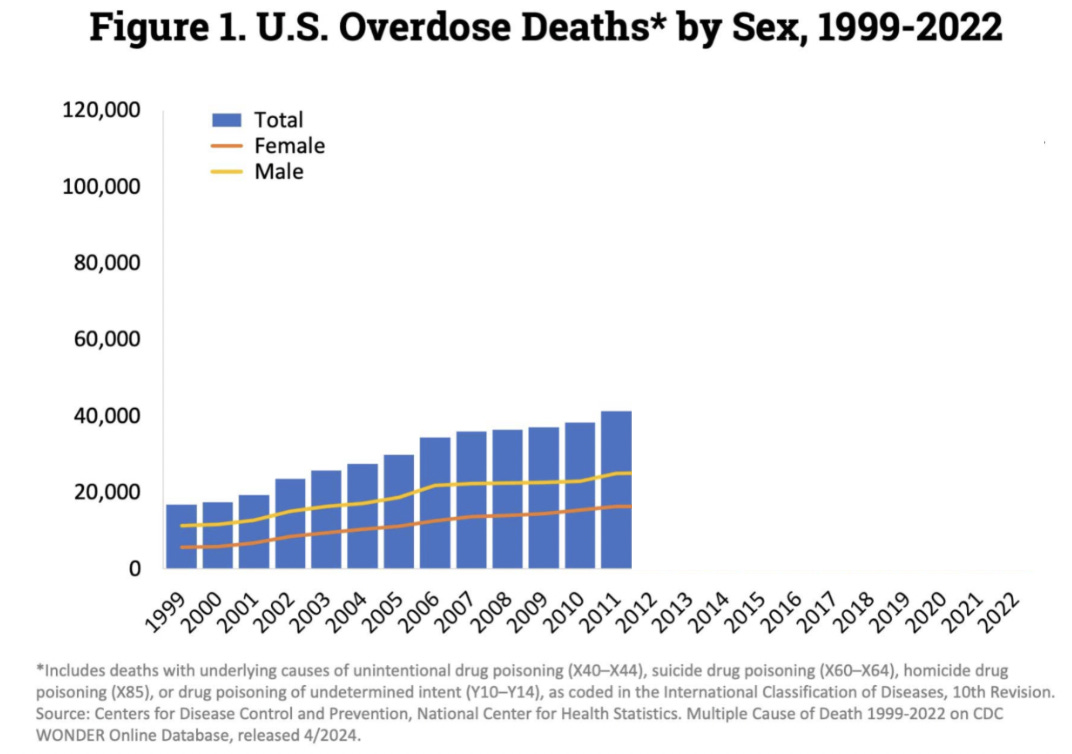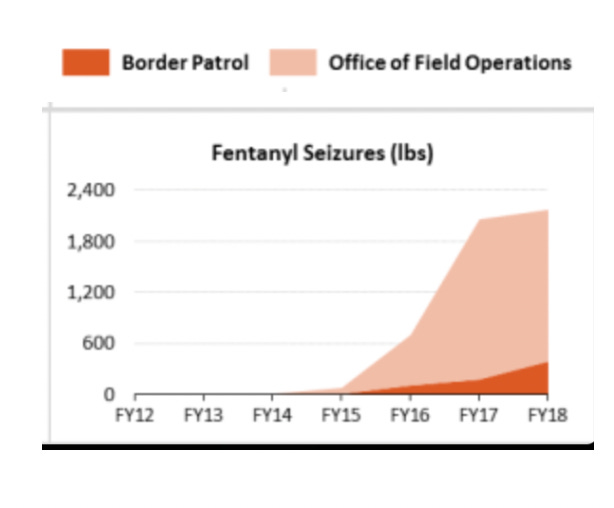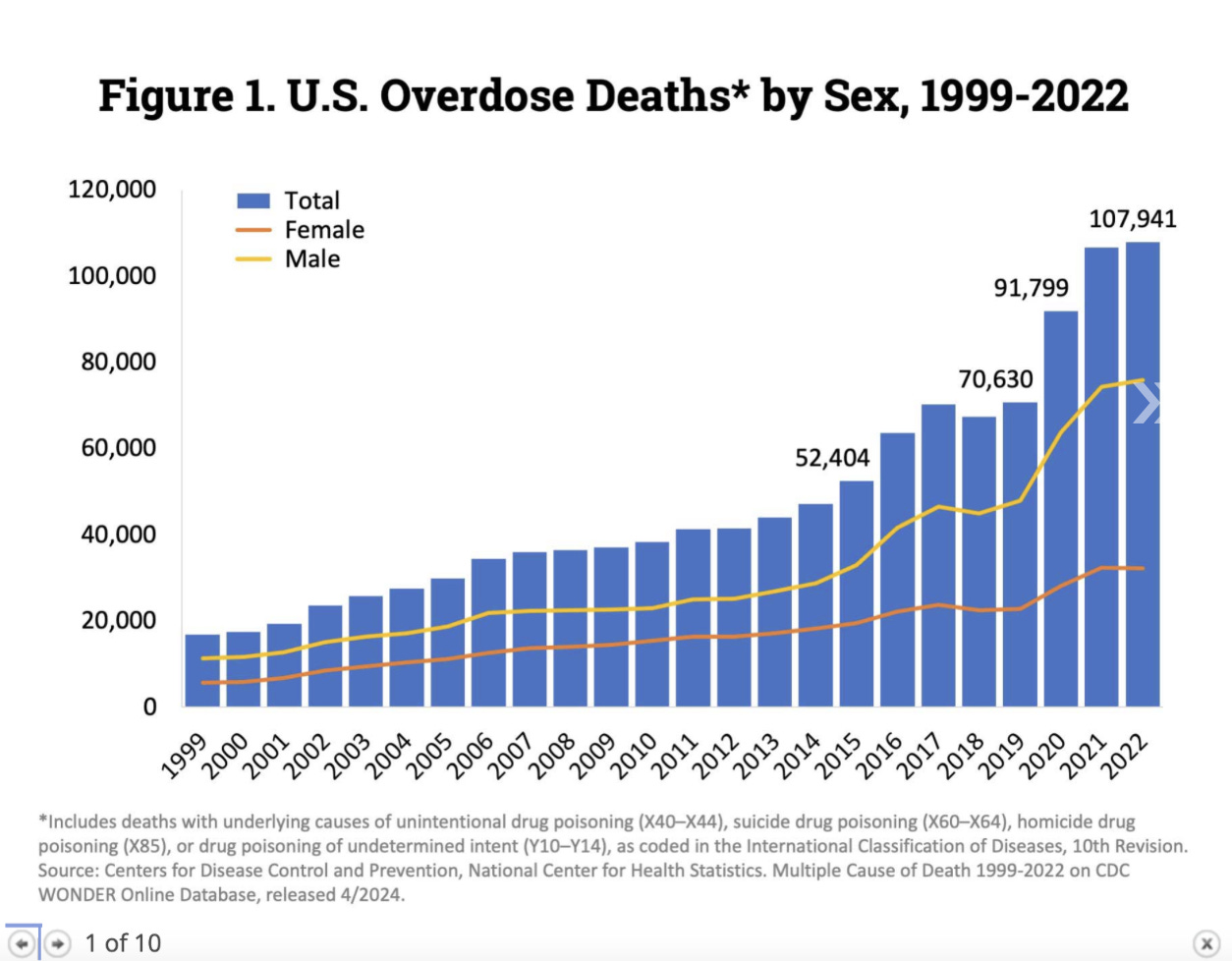Everyone remembers the "opiate crisis," right? Doctors being told oxies were non-addictive, passing them out like candy, people getting implausible amounts for simple procedures, then getting more and more on an ongoing basis as they developed “back pain?”
It was actually a fairly golden age, looking back - doctors had been pretty unhappy about the state of pain treatment for a while, in the sense there were no good treatments for chronic pain. Doctors were actually pretty jazzed to have a supposedly non-addictive opiate that could be used for pain treatment, because instead of telling people to suck it up, they could give them a scrip that would definitely work and treat their pain.
"We now have an opioid analgesic with less than 1% risk of addiction when prescribed for pain."
—Dr. J. David Haddox,
pain management expert and former Purdue Pharma executive
So in one sense, this was bad. People were using and getting addicted to pills. But in an important, larger sense, this was actually mostly fine. Overdose deaths at this point were ~20k a year. Having legal opiates of known strength may have led to addiction, but it led to many fewer deaths than today.
But see that curve steadily creeping up there, going from <20k to 30k, to mid-30k? This is about when the government began worrying about the “opiate crisis.” Something was rotten in the state of medical care! So obviously, they did the sensible thing and resolved to do whatever they could to triple these deaths as quickly as possible - at which they succeeded *amazingly!*
Well, that wasn’t exactly their intent, that’s just the result.
But let’s look at what happened. Probably starting around 2010 / 2011, people start worrying about this trend, and decide that whoops, we messed up, seems like oxies are addictive after all. So what was their solution?
To start cracking down on doctors in the US, telling them to prescribe 10x fewer legal and safe opiates or lose their license, which doctors immediately started complying with.1
But DEMAND doesn’t just disappear if doctor’s won’t prescribe pills any more. People still have pain and / or addictions, and this crackdown drove people to the street. And there was a sharp rise in heroin deaths as people used to pills transitioned to unknown-strength illegal street drugs:
That blue line rising is new incremental heroin users who aren’t used to it beginning to use and dying. That’s the 2010 - 2015 part of the story. But if you look at this guy, you might immediately perceive that “Hey! Total deaths didn’t decrease at all, they went up!” And you’d be right!
That first crackdown brought us neatly to ~52k deaths per year, for an incremental bonus “first crackdown 15.”
So obviously THAT won’t do! We started this whole mess because we wanted that line to go DOWN! We didn’t mean for you jerks to go get heroin after we refused to give you any more pills, leaving you addicted and going through withdrawal! Let’s try cracking down harder.
And lo, the government didst crack down yet harder, and increased heroin interdiction substantially in 2015:
So you see that big peak in 2015? There was an increase in heroin smuggling into the US because of all the latent demand from the suddenly cut off oxy people who couldn’t get safe, legal pills any more, and then an attendant bigger increase in interdiction as we stepped up efforts to intercept more.
They also came out with the 2016 CDC Opiate prescribing guidelines, which were much stricter, and were used as the basis for many states implementing explicit limits and stricter prescribing criteria.
But once again, supply and demand matter - that DEMAND is still there, and it’s gonna be filled somehow.
So what’s better than heroin?
By cracking down harder on shipments of heroin from Mexico, they left a supply gap that the Chinese filled with fentanyl. Because fentanyl and carfentanyl is 100-10,000 times stronger, it is correspondingly 100-10,000x lower in volume for smuggling, and much harder to catch. When one kilo can feed the streets for a month, which would have required a thousand kilos of heroin, it's much harder to interdict. It's also cheaper! So all the drug dealers decided "hey, it's cheaper and I get more of my shipments through, let's just sell this stuff exclusively," and lo, the fentanyl epidemic was born out of US gov policies and straightforward supply / demand forces. They even come in convenient "fake oxy" form, with much Chinese fentanyl coming over in pre-pressed pills.
And lo, we see fentanyl seizures skyrocket starting in 2015, as producers race to fill the demand:
But there’s some bad news here. Fentanyl causes WAY more overdoses than other opiates.
The primary reason fentanyl overdoses happen is that the difference between 3mg of fentanyl and 5mg of fentanyl is the difference between "feeling good" and "overdose."
When fentanyl contaminates other drugs like cocaine and mdma, or when fentanyl is pressed into pills, there can be a "chocolate chip cookie" effect, where it's not evenly mixed, and a local surplus forms a "chocolate chip" of fentanyl in the other drug / pill. Oops, that chip was 5mg instead of 3mg and you're dead now.
The reason fentanyl kills people is because it's added in imprecise amounts with slapdash mixing to either masquerade as heroin or opiate pills, or to add more addictiveness and oomph to other drugs, and the imprecision and slapdashery is killing people because of the 3mg / 5 mg thing.

And indeed, overdose deaths yielded not, and stubbornly persisted with their increase!
From 50k to 60k, thence to 70k, thence 90k, finally ending at ~108k annual deaths!
Let me give you some comparison points, because 80k incremental deaths a year is significant:
That’s a Palo Alto or Albany completely wiped out, ghost town, all dead, every year.
In two years, it’s an Alexandria, VA, or Escondido, CA.
In three years, it’s a Baton Rouge or an Irvine.
In 4 years, it’s a Newark, NJ or a Plano, Tx.
In 5 years, it’s a Miami or an Oakland.
In 6 years, we’ve lost the equivalent of a Kansas City or Atlanta.
This is a TON of people!
I hear you scoffing. These are drug addicts! Creeps! Losers! Assorted degenerates! It’s not like losing a Palo Alto or an Atlanta, it’s like being at war and somebody bombs one of your prisons!
But actually, a lot of them are young people, and a lot of them weren’t necessarily even addicts, which I’ll get to shortly.
Overdose deaths are now the biggest cause of death for Americans under 40, even bigger than car accidents. We’re killing 80k incremental young people a year, just so we can pretend we’re “tough on crime.”
What next?
I run across a lot of people that think the answer is CRACKING DOWN FOR REAL. You know, with emphasis. With ALL CAPS, and ITALICS even, and probably cudgels! I would love to give these people some cudgels and just let them go to town on some kilos of fentanyl - you know, really give them the business. Whack them into next week! You show those phenethylated piperidines!
Of course, they’d all die, because they’d be aerosolizing it and it only takes 5mg to kill somebody. But they’d die HAPPY, and feeling like they’d made a real difference, true to their philosophy to the end!
But obviously, cracking down hasn’t worked. And it really CAN’T work when a single kilo of fentanyl can feed a major city for a month, and a single kilo of carfentanyl can feed 100 cities in the US for a month. And you’re going to be able to interdict that single kilo in the ~2.4M containers that come into the US every month? Good luck with that.
So what might actually work?
In my own opinion, the only thing that might save these incremental ~80k lives a year is being willing to pass out legal opiates of known strength and purity again. Wholesale legal opiates are dirt cheap in reality - even very heavy addicts can be high out of their mind on ~$5 a day.
With pharmaceutically pure non-fentanyl stuff, addicts can live and work and function in society for decades. Just look at William Burroughs or Keith Richards!2
And to be clear, I mean bring back pill mills.
Make it MUCH easier to get scrips by going to a doctor, or to get pharmaceutical pills for free by going to the existing methadone centers and the like.
There should be no incremental crime or homelessness, because being able to get high for $5 a day (or free at existing clinics) is affordable enough nobody is going to need to turn to crime for it.
And if they do, I’ve got a proposal for them, too if $5 a day or going to clinics is too much.
Addicts don't even LIKE fentanyl more, for the most part, it's purely driven on the supply side by concentration and smuggleability. Heroin is preferred by between 1.7-6.7x, with older folk preferring it more.3
And although giving people safe, legal opiates is a pipe dream in the US, they've done it in Canada with some decent preliminary results:
Safe supply reduced nonlethal OD's 5.5x, ER visits by 14 annually, and by 5 hospital admissions annually (and there were zero lethal OD's in the study period).4
It's been hard to measure safe supply's impact on lethal OD's in the ~2 years it's been around, because the base rate is still fairly low, but there should be enough data for papers to come out in 2025 that have a read on it.5
Addiction matters less than deaths
So the funny thing is, these 80k incremental deaths is 100% a choice that could be largely eliminated, basically tomorrow.
If the government had just shut up and let the Sacklers make more millions, we would probably have ~600k more people alive today.
And sure, those are drug addicts! Who needs em? Buncha deviants and ne'er do wells. And have you heard the music they like??
But addiction is temporary, and death is *permanent.*
Many fentanyl deaths are from people who aren’t homeless, and aren’t addicts! This is because dealers either deliberately put it into faked prescription pills, or carelessly let it contaminate, cocaine, molly, and speed, and then people using those things die - in at least one state where it was measured (Maryland), the great majority of fentanyl overdoses involved cocaine (64%) or prescription pills (18%).6
A lot of the 600k incremental dead people weren’t homeless addicts, they were high school kids and young adults trying to do “regular” drugs who died incidentally, as the age distribution peaks young, encompassing ages 15-40, and generally peaking around age 30:7
Many of these people could have straightened up and gotten jobs and had kids. Actually, at the Sackler stage, a lot of the now-dead people *already* had jobs and kids and were mostly doing fine. It was the first crackdown that pushed people to illegal heroin, and then the second interdiction crackdown that pushed the entire market to fentanyl, and now we kill ~100k+ people a year, many of whom could eventually have been productive adults.
The case for pill mills
What is that change that could eliminate these deaths in a very short amount of time? Safe, legal opiates, at scale. How do you starve fentanyl and get rid of the market forces that make it the only opiate available? With safer, known-strength opiates, and with doctors able to pass out safe, legal opiates, to as many people as ask for them again.
Pill mills, in other words.
But, people will use those to get *high!* Yes. That’s totally the idea. People right now are getting high using 5x more dangerous stuff, and it’s killing 80k incremental people a year. The only way to displace the dangerous stuff, which you CANNOT keep from getting smuggled in, is to let people get high with safe stuff.
I don't care if more people get high legally, with much fewer negative health effects than alcohol. The worst health effect from pharmaceutical opiates is generally constipation. Compare with alcohol, which is a literal poison physiologically,8 and has attendant social impacts on drunk driving, domestic violence, homicides, and much else.
Cracking down doesn’t work. I hope we can see that by now. That's what's brought us to our current 5x young-people-death rate.
Or you know, maybe we should crack down even HARDER harder, and just do a Rodrigo Duterte and call it "death penalty for any drug user," and give all police Judge Dredd style powers to directly execute whoever they feel like, as long as they throw a little baggie of drugs on top of the corpse afterwards.
Would that be a better society, you think?
Because that's about the only option we have on the "no, harder" scale after this. Because you can't stop or interdict a kilo a month coming in a stream of 2.4M containers a month, but you can loosen up guidelines and enforcement and sell pharmaceutical doses at cost and at scale.
And why pill mills instead of full legalization? The little bit of friction is valuable. We don’t need opiates sold at 7-11, or companies advertising oxies on billboards and Tik Tok everywhere. But a cheap, safe supply dispensed to people who will go to the trouble? That’s the way to prevent tens of thousands of fentanyl deaths per year.
The standard insurance company valuation of a life is ~$9M. Do you know what that 80k deaths shakes out to? $720 billion a year.
But those are drug addicts! Reprehensibles! Wastrels! They’d have just been in prison costing us money if they hadn’t died!
But again, the biggest age peak encompasses 15-40, and most were doing cocaine or prescription drugs. They’re mostly kids and young adults trying to have some fun. Those people had another ~60 years in them! You think in ALL that 60 years, NONE of them would have done anything productive with their life? Even if you’re maximally pessimistic and write off 2/3 of them, that’s still ~$240B a year and 26k+ American lives we’re throwing away every year.
Stop the madness - save a Palo Alto-worth of people every year - bring back pill mills!
That’s a fairly loose summary. They actually proceeded by first investigating and revoking licenses from a bunch of doctors, then closing down various pill mills and pain centers, and ultimately coming out with the 2016 CDC Opiate prescribing guidelines, which were much stricter, and were used as the basis for many states implementing explicit limits and stricter criteria. This was (unsurprisingly) later recognized as having a “chilling” effect on doctors’ willingness to prescribe any opiates:
“It is recognized that between the Board’s death certificate project [one of the investigating and revoking projects] and the CDC 2016 Guidelines, a chilling effect was felt and physicians became less willing to treat patients with chronic pain.”
And the following is from a spate of closures in 2021 in California only, but it’s fairly representative of the process:
“Approximately 20,000 patients were left without referrals or treatment plans resulting in potentially dangerous disruptions in care for patients receiving treatment with opioid therapy.”
And the 29 closures and 20k patients mentioned here is just for California, this was writ large nationwide in most states.
Keith Richards’ autobiography is a pretty fun read, incidentally
*Ferguson et al, Investigating opioid preference to inform safe supply services: A cross sectional study (2022)
Although to be fair, there is a split. Some people are so far gone they can ONLY get high on fentanyl, and regular opiates aren’t strong enough now because they’ve worked their way up the curve to massive doses of fentanyl, which is 10-100x stronger.
*Lew et al The impact of an integrated safer use space and safer supply program on non-fatal overdose among emergency shelter residents during a COVID-19 outbreak: a case study (2022)
*Gomes et al Clinical outcomes and health care costs among people entering a safer opioid supply program in Ontario (2022)
I have been talking to a health care worker in Canada who tells me that Safe Supply has been vastly expanded and it's been a bad thing, because now it's big enough that organized crime has gotten involved, and trades money or fentanyl for the safe supply homeless people's pharmaceutical opiates. If that's true, we'll have to see how it comes out in the data - obviously if they're still using illegal fentanyl rather than the safe ones, deaths probably won't drop much. But pill mills used by non-homeless 15-40 year olds trying to have a little fun shouldn’t have this problem.
An analysis from Maryland overdose deaths with n=6.5k found that 64% of fentanyl overdoses involved cocaine, and 18% involved prescription pills, and it’s quite common for fentanyl to be pressed into fake prescription pills.
Park, et al. Polysubstance Overdose Deaths in the Fentanyl Era: A Latent Class Analysis (2023)
The biggest peak generally includes ages 15-30, maxing out around age 30, nationwide and particularly in any western states. Then there’s an age 50-60 “shoulder” nationwide, with NYC in particular having a right-shifted distribution with a peak around 60:
Bottcher et al. Forecasting drug-overdose mortality by age in the United States at the national and county levels (2024).
To the extent the average male russian life expectancy is 68, versus 78 for russian women, with that immense country-wide delta due to alcohol consumption









Supporting what you propose would be Journavx, the non-opiate analgesic the FDA just approved.
No idea how to pronounce the name, but the effectiveness data looks strong.